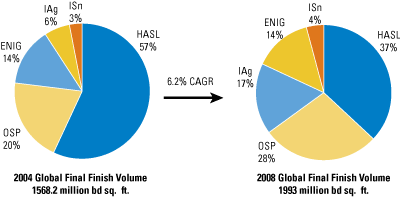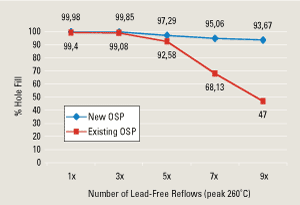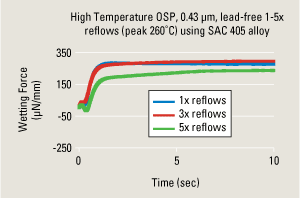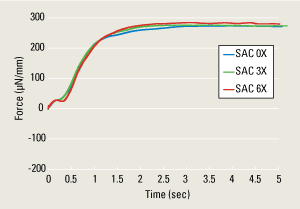Immersion silver and high temperature OSPs meet the manufacturer’s goals of low cost and ease of use, and the assembler’s need for high first-pass yields and improved long term reliability.
In order to meet the requirements of RoHS, including the elimination of lead from electronic components, the printed circuit board industry is moving away from lead bearing hot air solder leveled (HASL) final finishes to alternative materials. To date, the electronics industry has yet to adopt a universal HASL alternative. As recently as 2004, HASL still retained over 50% market share of the final finishes used in PCB manufacturing. While the share has steadily declined over the past 18 months, at the close of 2004 the worldwide use of lead containing HASL materials still exceeded 55% (Figure 1).
|

FIGURE 1. Worldwide final finish market for 2004 and projection for 2008.
|
Predicting the winning replacement for HASL has been a difficult task. There are a number of likely contenders, including organic solderability preservatives (OSPs), electroless nickel/immersion gold (ENIG), and other metallic immersion technologies such as silver and tin. To date no single material has risen to a position of market dominance. The best of the alternatives on a global basis are OSPs that can claim a higher market share than any of the others. This is partly due to OSP’s time in the marketplace compared to other technologies, but furthermore the proven highest joint reliability compared to other alternatives. A high level of acceptance was obtained for OSP technology in the mid 1990s as a cost effective process that demonstrated suitable assembly robustness. Market share continues to grow with new OSP technologies with the recent shift to lead-free processing.
The three main drivers that push the electronics industry to consider HASL alternatives are cost, technology and the need for a new lead-free material to meet RoHS requirements. The top drivers for final finish conversion today are the existing EU RoHS directives and the upcoming China RoHS legislation. These far reaching environmental initiatives have created the need for fabricators to eliminate lead from the process, driving lead containing HASL towards extinction. The impact of RoHS can be felt in both PCB design and manufacturing, from laminate selection to final finish choice. These changes cannot be taken lightly because they impact the assembly process as well. When selecting a new process to meet the requirements of RoHS, it is necessary to ensure not only that the end product meets the basic lead-free requirement, but also that the overall process selected will provide ease of use in the manufacturing environment, lowest cost of ownership and the highest assembly yields.
There has been a steady migration away from lead containing HASL, which was once the top final finish choice for PTH and SMT assembly, to alternative materials including OSPs, immersion silver, immersion tin and ENIG or ENEPIG (incorporating electroless palladium as a barrier layer between the nickel and the gold). Figure 1 shows the worldwide market share for the various final finishes in 2004, pre-RoHS, and projections for 2008 market shares. Based on current trends, both OSPs and immersion silver are projected to claim the lion’s share of volume as it shifts from HASL to an alternative finish. This is because these finishes are the best fit for the other two drivers noted above – technology demands and cost.
Comparison of RoHS Compliant Final Finish
The use of most well known HASL alternatives seems to be different in each of the world regions. In Europe there appears to be a preference for ENIG and immersion tin final finish, although there seems to be a noticeable interest shift towards immersion silver. In the U.S. fabricators favor ENIG, and in Asia OSPs and immersion silver technologies are being used most extensively. The main reason for this can be tied back to specific OEM preference and specific assembly application.
Immersion silver provides a single surface finish that, under specific conditions, is wire bondable, embodies low contact resistance for key contacts and can provide metal-to-metal shielding. Although it is a newer finish, there are clear advantages. It is a versatile finish that could replace a great part of the HASL (and even ENIG) market. There have been some historical concerns with silver such as electromigration and sensitivity to oxidation. These limitations have primarily been associated with electrodeposited silver coatings. The latest generation of immersion silver technologies have overcome any lingering concerns about electromigration or solderability issues. In October of 2006, Underwriters Laboratories (UL) reconfirmed its acceptance of immersion silver as an approved final finish. The reconfirmation has made it easier for fabricators to qualify new immersion silver installation with UL. This will facilitate an increased utilization of immersion silver as a key RoHS compliant final finish. The UL also acknowledged that over 15% of all PCBs fabricated produced worldwide in 2006 already used immersion silver processes, and that any previous reliability concerns (including electromigration) were not a factor for today’s commercially available immersion silver processes.
OSPs have been a market leader for HASL alternatives worldwide and provide a wide process window for the applicator. There are still misconceptions that OSPs can only be used for single thermal excursion and need nitrogen and aggressive soldering materials. Experience and data have shown that in the last 10 years the generation of substituted benzimidazoles are fully compatible with no-clean assembly of mixed technology boards, and can withstand more than three heat cycles required for this type of assembly. Although nitrogen will help to improve wetting, it is not required. OSPs are the lowest cost surface finish available. A new generation of more thermally stable materials has been specifically designed to meet the lead-free assembly requirements1.
Immersion tin has been available on the market for some time and provides a thicker, uniform metallic coating for improved ICT probe life and lubricity for press fit pins. Although the cost is higher and processing of this finish is more difficult than for OSPs or immersion silver, it seems there is growing interest again for certain applications as fabricators and assembly operations work together to determine which of the available lead-free final finishes are most suitable for their demands. This is especially true in Europe, where the interest in immersion tin as a final finish seems high. Concerns related to whisker formation have been addressed with new additive systems by most of the suppliers of immersion tin chemistries.
Electroless nickel, followed by immersion gold, is a well-established surface finish that has been used for a number of years. While ENIG has demonstrated excellent solderability, the metallurgy of the solder joint itself comes into question. A benefit of ENIG is that the nickel provides a barrier between the copper and solder, allowing for less copper erosion and improved through-hole reliability. One of the main drawbacks to this process, and other gold and palladium containing processes, is their relative high cost. As the price of gold skyrocketed over $600/troy ounce in 2006, this was a significant factor limiting widespread adaptation of this method. Gold prices are still hovering above $600/troy ounce and this cost adder, coupled with the current high cost of electroless nickel, certainly limits the use of ENIG to those cases where the higher processing cost can be absorbed. A secondary consideration for manufacturers is that the chemistry is not as easy to use as other alternatives, requires a high level of routine control and cannot be easily conveyorized for high volume automation purposes. There is still a chance that the process will precipitate a compatibility issue with some soldermask materials during the fabrication process. Another major issue linked to this finish relates to the long-term reliability of the solder joint. While deemed “under control†by the latest generation of processes, Black Pad caused a number of high volume field failures of assembled PCBs in the late 1990s.
Lead-free Assembly
The assembly industry is currently evaluating lead-free soldering alternatives. While certain alloys seem to be the choice of specific OEMs, a common industry accepted alloy containing tin, silver and copper is preferred. All of the alloys being used require a higher reflow temperature and yield slower wetting speeds. Paste suppliers have engineered specific flux and paste chemistries to improve the wetting of these new alloys. The alloy type and the temperature of the soldering operation have the greatest influence on solderability, independent of the surface finish. Initial studies indicate that the higher reflow temperatures do not affect the solderability or joint strength of OSPs and immersion silver. The higher melting temperatures apparently help penetration of the OSPs and wetting of the silver surface even with double-sided reflow. These observations further support the rapid growth that has been seen with these particular final finishes. They exhibit good assembly robustness, increasing the likelihood of higher first-pass assembly yields.
OSPs for Lead-free Assembly
OSP processes provide a temporary layer to clean and protect the copper surface from oxidation. During soldering, the organic coating is penetrated, dissolved and chemically broken down by the flux or solder paste flux vehicle and heat of the soldering process. Past experience has provided an understanding of how soldering occurs on an OSP. In general, non-thermal cycled OSPs have good wetting properties, almost independent of materials or processes used. However, thermal cycling results in additional cross linking of the coating, making it slightly more chemical resistant and less penetrable by weak organic acids used in standard flux formulations. The profiles used in lead-free soldering and the higher temperatures involved will affect this phenomenon. Therefore a new generation of OSPs has been developed and released to withstand higher temperatures and make no-clean flux penetration easier, resulting in improved solderability.
|

FIGURE 2. Through-hole solderability comparison for traditional and high temperature OSPs.
|
The industry’s next generation OSPs have been specially formulated to meet the stringent demands of today’s most complex PCB lead-free assembly processes2. These innovations have been modified to provide a more thermally stable (i.e. higher temperature) coating without sacrificing the OSP’s well-established record of reliability. Compared to existing technologies this new generation of OSPs has the ability to withstand by far more than three lead-free thermal cycles without significant solderability degradation (Figure 2). This has been confirmed with wetting balance and solderability testing as well as production experience (Figure 3). Furthermore, this coating is fully compatible with mixed metal finish technologies such as ENIG/OSP assemblies.
|

FIGURE 3. Wetting force versus time based on thermal excursions.
|
All the data gathered using OSP indicate that lead-free thermal processing (with elevated temperatures) does reduce OSP’s wetting properties (i.e. larger wetting angle). However, the wetting angles for the lead-free alloys are still well below 90? and, consequently, should be suitable for lead-free processing. It is important, however, when using the new OSP for lead-free, that the material selection is critical. Many factors should be considered before implementation. Before choosing a supplier, one should consider the amount of thermal processing the parts will be exposed to, the kind of flux or paste that will be used, thermal profiles used, nitrogen or air, etc. All of these factors can then be used to determine the OSP type or supplier as well as the required OSP thickness for that particular process (Figure 4).
|

FIGURE 4. Comparison of SAC X0307 and SAC 305 alloys for solderability with a high temperature OSP. Both exhibit good solder fillet with the HT OSP final finish. SAC X0307 exhibited slightly better circumferential wetting.
|
Immersion Silver Performance
Immersion silver is one of the leading lead-free final finish choices for many OEMs in the telecommunications, computer, automotive and consumer electronics industries. As the interest in immersion silver has grown, a number of proprietary plating processes have been introduced. The first immersion silver process was introduced some 12 years ago. There have been numerous studies exploring the capabilities and advantages of the immersion silver-plating processes currently available in the marketplace.
One distinction among the various chemistries available has been thick vs. thin immersion silver coatings. Fundamental differences in the surface preparation and plating processes influence the performance of the various immersion silver coatings, resulting in different performance characteristics that are independent of the silver thickness. Earlier papers show that, at a given silver thickness, the tarnish resistance is different for silver coatings plated from different processes3. Because the deposit characteristics vary from process to process, the silver thickness requirements to ensure reliable performance at assembly should not be applied generically, but need to be determined in concert with the specific silver chemistry used.
Results for lead-free soldering with immersion silver have proven to be compatible with different lead-free alloys, even after multiple heat cycles (Figure 5). Not all processes have the same performance. The specific resistance to tarnish that a particular process has should be characterized to ensure the assembly of this final finish is successful. In addition, it has been demonstrated that the control of thickness and the deposition rate of the immersion silver, thus type of process chemistry involved, play a significant role in the reduction of eliminating microvoids and reducing galvanic attack.
|

FIGURE 5. Immersion silver solderability with SAC 305 alloy after 0, 3 and 6 lead-free reflow profiles with a 260?C peak temperature.
|
Solder Joint Reliability
Both alternatives, OSPs and immersion silver, provide an optimum surface for printing with all types of solder paste. The paste is placed directly on the surface finish, providing direct contact of the flux and wet the PCB surface. The stencil forms an effective gasket for depositing a perfect solder paste print, eliminating the smear and bridging issues of HASL. The result is high first-pass assembly yields with these alternatives. Differences in solder wetting can be observed dependant on the PCB finish, design and application4.
Several studies have demonstrated that soldering directly to the copper surface with OSPs provide the strongest solder joints. Solder joint strength becomes critical when smaller pad sizes are utilized with area array chip packages. When properly deposited, the gold on an ENIG surface is pure and will provide a fast wetting speed for soldering. However, when ENIG is used, the solder joint is formed on a nickel barrier layer, not directly on the PCB’s copper surface. A major concern found in the last years and still today is the black pad phenomenon with the assembly of BGAs, resulting in non-adherence of the solder balls onto the PCB surface.
Although many mechanisms and chemical solutions are provided, this is still a major issue with ENIG application. In combination with the high cost of this finish, there are also expectations that ENIG will be (partly) disappearing and replaced by one of the other alternative finishes such as OSP or immersion silver. The mobile industry has already switched over a few years ago to a mixed finish board whereas OSPs are being used to secure a strong solder joint and the ENIG finish is solely used for touch pad contacts.
Summary
The use of alternatives will not only increase, but will replace HASL as the final finish of choice. The problem with alternatives today is the number of choices and the amount of data that has been presented. Alternatives provide lead-free, highly solderable, flat, coplanar surfaces that, under production conditions, provide significant improvement in first-pass assembly yields. Matching each coating’s benefits to the specific assembly requirements and PCB design can differentiate the HASL alternatives.
Immersion silver is still a relatively new technology when compared to OSPs and ENIG, but has undergone extensive testing by many OEMs over the past 18 months. In 2006 numerous high volume production installations have come online that demonstrate the reliability of this process. The solder wetting characteristics make this coating more adaptable to an existing no-clean wave soldering process vs. an OSP coating.
Immersion silver is currently being considered as the most interesting alternative for most applications, including shielding, aluminum wire bonding, key contacts and soldering. The latest generation of silver processes recently introduced address the previous issues found in older technology including chemical stability, tarnishing and galvanic etching. Immersion silver and high temperature OSPs are the current market leaders for lead-free final finish materials. They meet both the manufacture’s goals for low cost and ease of use, and the assembler’s demand for high first-pass yields and long term reliability in lead-free assembly. PCD&M
Jim Kenny is global product line manager, PCB Final Finishes, at Enthone Inc. Frando van der Pas is European product manager, Final Finishes and Imaging Technologies, at Enthone Inc. Karl Wengenroth is R&D manager, PCB Final Finishes, at Enthone Inc. Dr. Yung-Herng Yau is a senior scientist at Enthone Inc. They can be contacted at This email address is being protected from spambots. You need JavaScript enabled to view it..
REFERENCES
1. Next Generation Organic Solderability Preservatives (OSPs) for Lead-free soldering and Mixed Metal Finish PWBs and BGA Substrates, Koji Saeki, Shikoku Chemicals Corp. Chiba Japan Michael Carano Electrochemicals, Inc. Maple Plain, MN, Presented at IPC Printed Circuits Expo SMEMA Council APEX, Designers Summit 2004.
2. Lead-free Soldering of Organic Solderability Perservatives, Frando van der Pas and K.H. Wandner, Enthone – Cookson Electronics, published in Printed Circuit Europe – 1st Quarter 2001.
3. The Chemistry and Properties of a Newly Developed Immersion Silver Coating for PWB Yung-Herng Yau, Chonglun Fan, Chen Xu, Anthony Fiore, Karl Wengenroth and Joe Abys Cookson Electronics PWB Materials and Chemistry, West Haven, IPC Printed Circuits Expo SMEMA Council APEX, Designers Summit 2004.
4. Joint Industry Standard: Solderability Tests for Printed Boards, IPC/EIA J-STD-003A, September 2002.


















